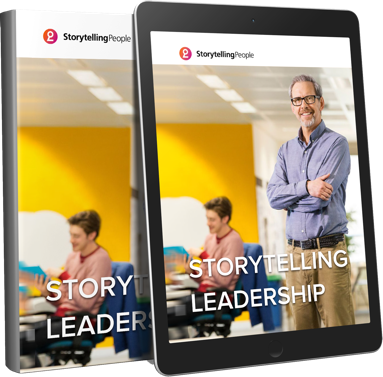‘Leaders with a story are more successful’
Leaders are role models. Earning employee respect as a leader is the first essential key to employee engagement. It is what leadership is all about. Choose storytelling leadership if you want to work in-depth on a focused programme for connecting leadership either on an individual or group level.
Storytelling leadership
Storytelling: what, how and why? Although we can often be incredibly rational creatures, ultimately we are all susceptible to being swept away by a great story. We enjoy being moved or touched by a story. This makes us suddenly realise that we ‘have a certain something’ in common with a company, a brand and an organisation. Stories have the capacity to show people things and allow them to experience things they might otherwise miss. Stories illustrate corporate values and give a human face to a company’s vision, ambitions and core values. Stories connect people to one another, involve them in the organisation, inspire and energise them, and make them proud of their collective achievements. Organisations with a story are future-oriented. The story clearly answers the questions: who are we, in what ways are we unique and what is our purpose?
How can you motivate others to take action?
In his book, The Leader’s Guide to Storytelling, Stephen Denning introduces the springboard story as a way to help set people in motion. A springboard story is a story that energises its listeners and gets them moving toward creating a new future.
Although not an exact science, the story consists of about nine elements that need to be included. The first four elements are the most important, the other elements are optional:
• there is a clear objective that defines the desired change
• it is a true story of a successful process of change
• the story contains a clear core message
• the story is told from the point of view of a single main character
• the story takes place at a specific time and place
• the story makes clear what would have happened had the change not taken place
• it is a positive story
• the story is linked to the desired objective
Why is leadership relevant?
Employee engagement is bolstered by the respect employees have in your leadership. That translates into higher customer satisfaction and greater financial performance. Investing your efforts into building respect in leadership is what makes the difference. Increasing employee engagement revolves around taking actions such as creating internal ambassadors. Companies that spend time and energy on transparency, working on confidence, clarifying the Why, providing insight into decisions, sharing successes and helping people participate in the daily work of their CEO, board and top managers will see that reflected in rising employee engagement scores.
Mission, vision and objectives: these add up to a complete story. Now the time has come to share it with your employees in the form of a presentation. This is your chance as a leader to make an enduring impression and to introduce a new dynamic into your company. Good preparation is half of the work.
Employees expect leadership from you. They expect you to define opportunities and outline perspectives. But how can your make the most lasting impression with your message? How do you create enthusiasm and conviction in the company; the fuel that drives change? You do not even have to take very big steps; the secret lies in remaining true to yourself. You know how to tell a story with fire. And you allow your story to spark the attention of your audience
Who are you?
Leading a company means being consistent, recognisable and even predictable. This is the basis of credibility. Leadership is directly connected to the future. Good leaders are able to visualise the future before it becomes reality. What connects us? What is our purpose? The company that does not take the time to ask and answer these questions is selling itself short. The demand for organisations with credible stories has increased considerably. If there is one aspect that is important at this time, it is unity of identity and ambition. This not only means that everyone is heading in the same direction but that they are also doing so willingly.
Personal story as a leadership story
People have different levels in their lives. On the surface, your daily life consists of daily routines, achieving what needs to be done at work. On a deeper level are your true feelings: the highs and lows in your life, the experiences of disappointment and of joy. Normally, we only show the surface to others but our uniqueness is embodied in that deeper layer. It is this layer that can communicate who we really are. In addition to the story, it is important to be aware of how you tell the story and with what level of conviction. An effective story is authentic and comes from your innermost convictions.
You show leadership by being yourself. Questions arise every time you start in a new organisation or role, or when you are involved as a consultant for a new organisation, such as:
“Who is this person?”
“Where are they from?”
“What do they have to offer?”
“Can they be trusted?”
Presenting yourself through storytelling is a great way of responding to these questions. The right story lets everyone know who you are. It turns a stranger into a familiar face. Stories from your own life and experiences are perfect in this case.
The leadership story is your signature as a manager; how you have learned to motivate people over the years. You are used to taking responsibility and to making tough decisions. You want to include people in your vision and your perspective on the future. How can you do that? What key words are at the core of your personal story? What are your most meaningful leadership experiences? On what considerations or convictions do you base your decisions? How do you deal with logic and emotion? What is your most important message for binding leadership?
Share:



